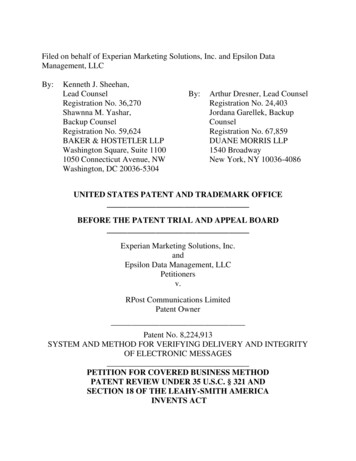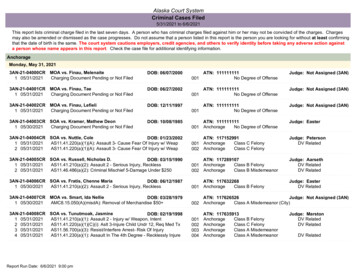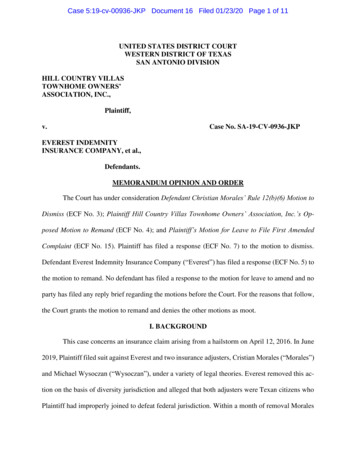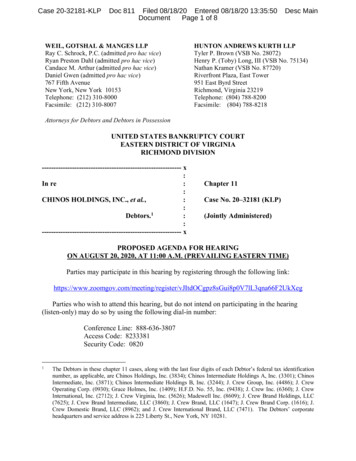
Transcription
Filed on behalf of Experian Marketing Solutions, Inc. and Epsilon DataManagement, LLCBy:Kenneth J. Sheehan,Lead CounselRegistration No. 36,270Shawnna M. Yashar,Backup CounselRegistration No. 59,624BAKER & HOSTETLER LLPWashington Square, Suite 11001050 Connecticut Avenue, NWWashington, DC 20036-5304By:Arthur Dresner, Lead CounselRegistration No. 24,403Jordana Garellek, BackupCounselRegistration No. 67,859DUANE MORRIS LLP1540 BroadwayNew York, NY 10036-4086UNITED STATES PATENT AND TRADEMARK OFFICEBEFORE THE PATENT TRIAL AND APPEAL BOARDExperian Marketing Solutions, Inc.andEpsilon Data Management, LLCPetitionersv.RPost Communications LimitedPatent OwnerPatent No. 8,224,913SYSTEM AND METHOD FOR VERIFYING DELIVERY AND INTEGRITYOF ELECTRONIC MESSAGESPETITION FOR COVERED BUSINESS METHODPATENT REVIEW UNDER 35 U.S.C. § 321 ANDSECTION 18 OF THE LEAHY-SMITH AMERICAINVENTS ACT
TABLE OF CONTENTSPageI.INTRODUCTION .1A.Overview of the ’913 Patent.2B.The Prosecution History of the ’913 Patent .4II.MANDATORY NOTICES (37 C.F.R. § 42.8) .6III.GROUNDS FOR STANDING (37 C.F.R. § 42.104(A)).8A.At Least One Challenged Claim is Not Patentable .8B.The ’913 Patent is a Covered Business Method Patent .8C.The ’913 Patent is Not Directed to a Technological Invention.15D.Petitioners Have Been Sued for Infringement and Are Not Estopped(37 C.F.R. § 42.302) .18IV.PERSON OF SKILL IN THE ART DEFINITION.18V.STATEMENT OF PRECISE RELIEF REQUESTED FOR EACH CLAIMCHALLENGED (37 C.F.R. § 42.22(A)) .19VI.A.Review is Requested for All Claims (37 C.F.R. § 42.304(b)(1)) .19B.Statutory Grounds of Challenge (37 C.F.R. § 42.304(b)(2)) .19C.Claim Construction (37 C.F.R. § 42.304(b)(3)) .201.Broadest reasonable interpretation.202.The ’913 Claim Terms .211.The Preambles Are Limiting .222.Server Acting as a Mail Transport Agent .24LEGAL STANDARD FOR PATENT VALIDITY .25A.General Principles .25B.Anticipation .25C.Obviousness.261.The Scope of the Pertinent Art. 262.The Level of Ordinary Skill in the Art .28i
3.Obviousness Cannot Be Based on Hindsight Reconstruction ofthe Invention .29VII. DETAILED EXPLANATION OF GROUNDS FOR UNPATENTABILITY.30A.Claims 1-11 are anticipated under 35 U.S.C. § 102 over CertifiedExchange of Electronic Mail (CEEM) .33B.Claims 1-9 Are Anticipated under 35 U.S.C. § 102 over CertifiedElectronic Mail (CEM).44C.Claims 10-11 are rendered obvious under 35 U.S.C. § 103 over CEMin view of Privacy Enhanced Mail (“PEM”).53D.Claims 1-3 are anticipated under 35 U.S.C. § 102 over Postfix .56VIII. CONCLUSION.61IX.FEE STATEMENT (37 C.F.R. §42.15(B)) .61ii
TABLE OF AUTHORITIESPage(s)CASESAkzo N.V. v. U.S. Int’l Trade Comm’n,808 F.2d 1471 (Fed. Cir. 1986), cert. denied, 482 U.S. 909 (1987) . 25Allen Eng’g Corp. v. Bartell Indus.,299 F.3d 1336 (Fed. Cir. 2002) . 20Andersen Corp. v. Fiber Composites, LLC,474 F.3d 1361 (Fed. Cir. 2007) . 21Astra Aktiebolag v. Andrx Pharms. (In re Omeprazole Patent Litig.),483 F.3d 1364 (Fed. Cir. 2007) . 25August Tech. Corp. v. Camtek, Ltd.,655 F.3d 1278 (Fed. Cir. 2011) . 20B.F. Goodrich Co. v. Aircraft Braking Sys. Corp.,72 F.3d 1577 (Fed. Cir. 1996) . 29, 30In re Bigio,381 F.3d 1320 (Fed. Cir. 2004) . 27Cable Elec. Prods, Inc. v. Genmark Inc.,770 F.2d 1015 (Fed. Cir. 1985) . 29, 30Catalina Mktg. Int’l, Inc. v. Coolsavings.com, Inc.,289 F.3d 801 (Fed. Cir. 2002) . 20In re Clay,966 F.2d 656 (Fed. Cir. 1992) . 27In re Deminski,796 F.2d 436 (Fed. Cir. 1986) . 27Environmental Designs, Ltd v. Union Oil Co. of California,713 F.2d 693 (Fed. Cir. 1983) . 28iii
Glaverbel Societe Anonyme v. Northlake Mktg. & Supply, Inc.,45 F.3d 1550 (Fed. Cir. 1995) . 25In re GPAC,57 F.3d 1573 (Fed. Cir. 1995) . 28Graham v. John Deere Co.,383 U.S. 1 (1966) . 26Heidelberger Druckmaschinen AG v. Hantscho Commercial Prods., Inc.,21 F.3d 1068 (Fed. Cir. 1993) . 27In re Icon Health & Fitness, Inc.,496 F.3d 1374 (Fed. Cir. 2007) . 27Impax Labs., Inc. v. Aventis Pharms., Inc.,468 F.3d 1366 (Fed. Cir. 2006) . 25In re Kahn,441 F.3d 977 (Fed. Cir. 2006) . 29KSR Int’l Co. v. Teleflex Inc.,127 S. Ct. 1727 (2007) . 26Minnesota Mining & Mfg. Co. v. Johnson & Johnson Orthopaedics, Inc.,976 F.2d 1559 (Fed. Cir. 1992) . 25Monarch Knitting Mach. Corp. v. Sulzer Morat GmbH,139 F.3d 877 (Fed. Cir. 1998) . 28PPG Indus., Inc. v. Guardian Indus. Corp.,75 F.3d 1558 (Fed. Cir. 1996) . 25Princeton Biochemicals, Inc. v. Beckman Coulter, Inc.,411 F.3d 1332 (Fed. Cir. 2005) . 27RPost Holdings, Inc. v. Constant Contact, Inc.,E.D. Tex. No. 2:12-cv-00510-JRG . 7RPost Holdings, Inc. v. Docusign, Inc.,E.D. Tex. No. 2:12-cv-00683-JRG . 7iv
RPost Holdings, Inc. v. Epsilon Data Management,LLC, E.D. Tex. No. 2:12-cv-00511-JRG . 6, 7RPost Holdings, Inc. v. Experian Marketing Solutions, Inc.,E.D. Tex. No. 2:12-cv-00513-JRG . 6, 7RPost Holdings, Inc. v. Infogroup, Inc.,E.D. Tex. No. 2:12-cv-00517-JRG . 7RPost Holdings, Inc. v. Strongmail Systems, Inc.,E.D. Tex. No. 2:12-cv-00515-JRG . 7RPost Holdings, Inc. v. Vocus, Inc.,E.D. Tex. No. 2:12-cv-00516-JRG . 7Seachange Int’l, Inc. v. C-COR, Inc.,413 F.3d 1361 (Fed. Cir. 2005) . 21Spectrum Int’l v. Sterlite Corp.,164 F.3d 1372 (Fed. Cir. 1998) . 21Standard Oil Co. v. Am. Cyanamid Co.,774 F.2d 448 (Fed. Cir. l985) . 28State Contracting & Eng’g Corp. v. Condotte Am., Inc.,346 F.3d 1057 (Fed. Cir. 2003) . 27STATUTES35 U.S.C. § 102 .passim35 U.S.C. § 103 .passim35 U.S.C. § 321 .1, 1935 U.S.C. § 324 .8, 61Leahy-Smith America Invents Act (AIA) .passimOTHER AUTHORITIES37 C.F.R. § 42.8 .6, 7, 837 C.F.R. § 42.104(a). 8v
37 C.F.R. § 42.300 .1, 2, 2037 C.F.R. § 42.301 .8, 15, 1637 C.F.R. § 42.302 . 1837 C.F.R. § 42.304 .19, 2077 Fed. Reg. at 48,737 . 1177 Fed. Reg. 48,734 (Aug. 14, 2012) at 48,735. 977 Fed. Reg. 157 (Aug. 14, 2012) at 48,734-35 . 12vi
I.INTRODUCTIONPursuant to 35 U.S.C. § 321, Section 18 of the Leahy-Smith AmericaInvents Act (“AIA”), and 37 C.F.R. § 42.300 et seq., the undersigned, on behalf ofpetitioners, Experian Marketing Solutions, Inc. and Epsilon Data ManagementLLC (collectively, “Petitioners”), hereby request a Covered Business Method postgrant review of claims 1-11 (all claims) of U.S. Patent No. 8,224,913 (“the ’913patent,” attached as Exhibit 1001).The ’913 patent is directed to a method and a system for electronic mailcertification. The ’913 patent discloses a “system and method for verifyingdelivery and content of an electronic message and . . . later providing proofregarding the delivery and content of an e-mail message.” ’913 patent at 1:20-25.As known by anyone who used electronic email communication prior to1999, verifying the delivery and content of an e-mail was well known in theindustry. Clark Decl. at ¶ 31. As demonstrated below, while the ’913 patent claimspriority to 1999, multiple prior art publications taught in detail exactly what isclaimed by the ’913 patent. None of this prior art was disclosed or consideredduring prosecution of the ’913 patent.For the reasons set forth in this petition, claims 1-11 of the ’913 patent areunpatentable, under 35 U.S.C. §§ 102 and/or 103, in view of the prior artpublications cited herein. Petitioners, therefore, respectfully request review of
these claims under the transitional program for covered business method patentsdefined in 37 C.F.R. §42.300.A.Overview of the ’913 PatentThe ’913 patent issued to Terrance A. Tomkow (“Tomkow”) from U.S. Pat.App. No. 12/952,076, filed on November 22, 2010 and claiming priority to U.S.Provisional App. Nos. 60/146,074 filed Jul. 28, 1999 and 60/172,479 filed Dec. 17,1999. The ’913 patent is entitled “System And Method For Verifying DeliveryAnd Integrity Of Electronic Messages.” The recorded assignments for the ’913patent indicate that the ’913 patent is putatively owned by RPost CommunicationsLimited, and putatively licensed exclusively to RPost Holdings, Inc. (collectively,RComm and RPH are referred to as “Patent Owner” or “RPost”). See Exhibit 1002.The ’913 patent discloses a “system and method for verifying delivery andcontent of an electronic message and, more particularly, to a system and method oflater providing proof regarding the delivery and content of an e-mail message.”’913 patent at 1:20-25. The ’913 specification describes the invention as being “asystem and method for reliably verifying via secure and tamper-proofdocumentation the content and delivery of an electronic message such as an email” with the desired purposes of giving “e-mail and other electronic messages alegal status on a par with, if not superior to, that of registered United States mail.”’913 patent at 3:6-11. In order to generate this “proof regarding the delivery and2
content of an e-mail message,” the ’913 specification requires, and the claimsexpressly recite, using a third-party Mail Transport Agent (MTA) that records atleast a portion of the SMTP (or ESMTP). See, e.g., ’913 patent at Fig. 1; 6:39-50;11:40-12:2; Fig. 8; and 24:60-25:31.This third-party MTA is essential to the invention claimed in the ’913 patent.In the DESCRIPTION OF THE RELATED ART section, the ’913 specificationdisclaimed the return-receipt methods known in the prior art that do not requireusing a third-party MTA:Many existing e-mail systems and e-mail programs already providefor some form of proof of delivery. For instance, some e-mail systemstoday allow a sender to mark a message with ‘request fornotifications’ tags. Such tags allow a sender to request notificationthat the message was delivered and/or when the message was opened. . . “[h]owever, this does not mean that an e-mail sent with anotification request is as effective in all respects as registered mail.’913 patent at 1:43-67. The use of the third-third party MTA was seen by theapplicant to be a necessary component in order to “provide reliable proof of thecontent and delivery of electronic messages” without “compliance of co-operationof the recipient” and “which requires no special e-mail software on the part of thesender or recipient.” ’913 patent at 2:65-3:1.The ’913 patent teaches using the MTA to relay the sender’s message to therecipient, while maintaining a record of the SMTP (or ESMTP) dialog between the3
MTA and the recipient as proof of the recipient’s receipt. See, e.g., ’913 patent atFig. 1; 6:39-50; 7:1-33; 8:4-8; 10:36-53 and claim 1 (“transmitting a message froma sender to a recipient through a server acting as a Mail Transport Agent.”).The ’913 specification further recites that “[t]he present invention includesan electronic message system that creates and records a digital signature of eachelectronic message sent through the system.” ’913 patent 3:18-20. However, the’913 specification clarifies that creating the digital signature is not innovative:“The digital signature can be created using known digital signature techniques,such as by performing a hash function on the message to produce a message digestand then encrypting the message digest.” ’913 patent at 3:55-58.B.The Prosecution History of the ’913 PatentIn a non-final Office Action dated June 9, 2011, the Examiner rejected theclaims under 35 U.S.C. 102(e) as being anticipated by Liu et al, U.S. Pat. No.6,760,752, as well as under 35 U.S.C. 103(a) as being unpatentable over Liu inview of “Network Design Manual: Storing and Forwarding With SMTP andMessage Transfer Agents,” Feb 23, 1999. See Ex. 1003 at 1003.161-167.In order to place the application in a condition for allowance, the applicantargued in an Amendment dated December 9, 2011 as follows:Claim 29 was amended, among other amendments, to recite recordingat the server some portion of the SMTP and ESMTP protocol dialogbetween the server and recipient, including portions in which the4
receiving Mail Transport Agent of the recipient accepts or declinesdelivery of the transmitted message. . . . Liu et al. discloses an emailsystem that uses various encryption methods and public and privatekeys. Information is passed back and forth between senders andrecipients. However, nowhere does Liu et al. teach or suggestrecording some portion of a mail transport protocol dialoggenerated during transmission of the message between the server andMail Transport Agent for a recipient, as is claimed in amended claim29.Ex. 1003 at 1003.151. In response to that same Office Action, the applicant alsoargued that:Moreover, while Liu et al does teach using conventional networkcommunication protocols such as HTTP, SMTP and the like totransmit electronic documents, Liu et al. does not teach or suggeststoring some portion of the dialog generated by those protocolsduring transmission of the document from the server to a MailTransport Agent of the recipient, as is claimed in amended claim 29.Using a protocol to communicate documents in a network is not thesame as recording some portion of the communications betweenservers and destinations that occur as the result of using that protocol.While persons skilled in the art would have been aware of the flow ofinformation that is part of the protocol, Applicant alone recognizedthe importance of storing the dialog that occurs between a serverand destination address that is generated when using a mailtransport protocol such as SMTP for later use in proof of themessage and proof of the delivery of the message.5
Ex. 1003 at 1003.150-151, Amendment dated December 9, 2011 (emphasis added).These remarks demonstrate how the applicant distinguished the inventionsclaimed in the ’913 patent from the prior art by arguing that the “recording [andstoring] at the server some portion of the selected one of the SMTP and ESMTPprotocol dialog” limitation in independent claims 1 and 10 was a critical distinctionbetween the prior art and the claimed inventions. It is important to note that claims2-9, which are dependent on claim 1, and claim 11, which is dependent on claim10, were allowed because they depend on a claim reciting the “recording”limitation. The dependent claims do not add any subject matter that could be usedto distinguish the ’913 patent from the prior art.II.MANDATORY NOTICES (37 C.F.R. § 42.8)The Real Parties-in-Interest (37 C.F.R. § 42.8(b)(1)) are Experian MarketingSolutions, Inc. and Epsilon Data Management, LLC (“Petitioners”). As of thefiling date of the petition, the ’913 patent was asserted against the parties-ininterest in RPost Holdings, Inc. v. Epsilon Data Management, LLC, E.D. Tex. No.2:12-cv-00511-JRG and RPost Holdings, Inc. v. Experian Marketing Solutions,Inc., E.D. Tex. No. 2:12-cv-00513-JRG (consolidated with -00511).6
Petitioners are aware of the following pending judicial matters in which thePatentees have asserted the ’913 patent that could affect, or be affected by, adecision in this proceeding (37 C.F.R. § 42.8(b)(2)): RPost Holdings, Inc. v. Epsilon Data Management, LLC, E.D. Tex. No.2:12-cv-00511-JRG; RPost Holdings, Inc. v. Experian Marketing Solutions, Inc., E.D. Tex. No.2:12-cv-00513-JRG (consolidated with -00511); RPost Holdings, Inc. v. Vocus, Inc., E.D. Tex. No. 2:12-cv-00516-JRG(consolidated with -00511); RPost Holdings, Inc. v. Constant Contact, Inc., E.D. Tex. No. 2:12-cv00510-JRG; RPost Holdings, Inc. v. Strongmail Systems, Inc., E.D. Tex. No. 2:12-cv00515-JRG; RPost Holdings, Inc. v. Infogroup, Inc., E.D. Tex. No. 2:12-cv-00517-JRG;and RPost Holdings, Inc. v. Docusign, Inc., E.D. Tex. No. 2:12-cv-00683-JRG.Lead Counsel and Backup Counsel for Experian (37 C.F.R. § 42.8(b)(3)) areKenneth J. Sheehan and Shawnna M. Yashar, respectively, both of BAKER &HOSTETLER LLP, 1050 Connecticut Ave. NW, Washington Square, Ste. 1100,Washington, DC 20036, phone 202.861.1500, facsimile 202.861.1783.Epsilon identifies Arthur Dresner as lead counsel and Jordana Garellek andJarrad Gunther as back-up counsel:Arthur Dresner, Reg. No. 24,403Lead CounselJordana Garellek, Reg. No. 67,859Jarrad M. Gunther, Reg. No. 63,903Back-up CounselDuane Morris LLP7
Back-up CounselDuane Morris LLP1540 BroadwayNew York, NY 10036-4086Telephone: (212) 692-1014Facsimile: (212) 202-4904Email: ADresner@duanemorris.comEmail: JGarellek@duanemorris.com30 S. 17th StreetPhiladelphia, PA 19103Telephone: (215) 979-1000Facsimile: (215) 979-1020Email: JMGunther@duanemorris.comFor service (37 C.F.R. §42.8(b)(4)) please direct all correspondence tobackup counsel at the above address. Petitioners consent to e-mail service atksheehan@bakerlaw.com, syashar@bakerlaw.com, , and JMGunther@duanemorris.com.III.GROUNDS FOR STANDING (37 C.F.R. § 42.104(A))A.At Least One Challenged Claim is Not PatentableAs further detailed below, claims 1-11 (all claims) of the ’913 patent areunpatentable under one or more of 35 U.S.C. §§ 102 and/or 103. Post-grant reviewis therefore warranted. See 35 U.S.C. § 324(a).B.The ’913 Patent is a Covered Business Method PatentThe ’913 patent is a “covered business method patent” (“CBM”) under§ 18(d)(1) of the Leahy-Smith America Invents Act, Pub. L. 112-29 (“AIA”) and37 C.F.R. § 42.301. A CBM patent is “a patent that claims a method orcorresponding apparatus for performing data processing or other operations used inthe practice, administration, or management of a financial product or service.” 37C.F.R. § 42.301. The scope of the CBM program has been refined by the USPTO’s8
rulemaking process. In particular, the USPTO has taken the position that a“financial product or service” should be “interpreted broadly” in view of the“legislative intent and history behind the public law definition [of that phrase] andthe transitional program itself.” Transitional Program for Covered ssMethodPatentandTechnological Invention; Final Rule, 77 Fed. Reg. 48,734 (Aug. 14, 2012) at48,735; see also id. at 48,734-35 (explaining that “the definition of coveredbusiness method patent was drafted to encompass patents ‘claiming activities thatare financial in nature, incidental to a financial activity or complementary to afinancial activity”) (citation omitted).During the March 2011 debates on the AIA, Senator Schumer addressed thefirst element of the “financial services” part of the “covered business-methodpatent” definition and noted that:The amendment covers not only financial products and services, butalso the “practice, administration and management” of a financialproduct or service. This language is intended to make clear that thescope of patents eligible for review under this program is not limitedto patents covering a specific financial product or service. In additionto patents covering a financial product or service, the “practice,administration and management” language is intended to cover anyancillary activities related to a financial product or service, including. . . marketing, customer interfaces, Web site management and9
functionality, transmission or management of data, servicing,underwriting, customer communications, and back office operations—e.g., payment processing, stock clearing.See 157 Cong. Rec. S1364–65 (daily ed. Mar. 8, 2011) (statement of Sen.Schumer) (emphasis added). Later, during the September 2011 debates, SenatorSchumer further clarified that “[s]ection 18 does not restrict itself to being used bypetitioners whose primary business is financial products or services. Rather, itapplies to patents that can apply to financial products or services.” Id. at S5432(daily ed. Sept. 8, 2011) (statement of Sen. Schumer).The ’913 patent specification makes clear that the claimed electronicmessaging system and methods are directed to financial, monetary, andcommercial applications. Specifically, there are several express statements in the’913 patent specification directed to financial or monetary transactions, including: “This evidence can be presented any time a dispute arisesregarding the content and delivery of messages, as for examplein contract formation, the timing of stock buy or sell orders,and many other applications.” Id. at 17:46-49 (emphasisadded); “In addition to the revenue sources available in otherembodiments, in this embodiment the operators can chargestorage fees for receipts held in the web based mailbox.” Id. at23:35-37 (emphasis added); and10
“The registered queries, complaints, orders, offers to purchase,and other information 46 are sent to the e-business 30 by thesystem. Receipts are then provided to the customers 34 viaSMPT server 38.” Id. at 26:36-39 (emphasis added).The USPTO has specified that additional guidance regarding the scope ofthe CBM Program should come from decisions on petitions as the PTAB makesthem. See 77 Fed. Reg. at 48,737. In clarifying which patents qualify for CBMreview, the PTAB has found that the term “financial product or service” shouldinclude patents claiming activities that are “complementary to a financial activity”and activities that “relate to monetary matters.” SAP Am., Inc. v. Versata Dev.Group, Inc., CBM2012-00001, Doc. 36 at 23 (stating that “[t]he term financial isan adjective that simply means relating to monetary matters”) Id. (emphasisadded).The ’913 patent relates to monetary matters. For instance, the ’913specification describes the invention as being an e-mail system used in “ecommerce.” Id. at 3:42-46 (“For corporate or e-commerce users, these users canchange their server to a server incorporating the present invention and have all oftheir external electronic messages registered, with the option of having the systemretain and archive the receipts.”). E-Commerce or the Electronic Commerceindustry is defined as a type of industry where the buying and selling of productsor services is conducted over electronic systems such as the Internet and other11
computer networks. E-Commerce, like all commerce, revolves around commercetransactions which involve money.To make these transactions possible, e-commerce necessarily draws ontechnologies such as mobile commerce, electronic funds transfer, on-linetransaction processing, and electronic data interchange (EDI). See, EncyclopediaBritannica, E-Commerce, attached as Exhibit 1004 (defining e-commerce asencompassing “secure electronic transfer of sensitive information (such as creditcard numbers and electronic funds transfer [EFT] orders)”). Consequently, ecommerce transactions represent exactly the type of activities that are“complementary to a financial activity” and “relate to monetary matters,” assupported by precedent, the USPTO rulemaking commentary, and the legislativehistory behind the AIA. See, e.g., SAP v. Versata, CBM2012-00001, Doc. 36 at 23;77 Fed. Reg. at 48,734-35; and 157 Cong. Rec. at S1364-65.More support for the ’913 patent being the exact type of patent contemplatedfor CBM review can be found by looking at the claims themselves. Claims 5, 6, 8,9 and 10 of the ’913 patent require the use of “encryption” which the ‘913 patentspecifications describes as being valuable in the e-commerce and financialindustries because it is used to provide proof that “an order [has been] placed.”’913 patent at 2:4. The specification goes on to explain that proof of delivery of a12
message is necessary in cases “where acknowledging receipt of the message wouldplace a financial or legal burden on the recipient.” Id. at 2:40-42.As noted in the legislative history of the AIA, Section 18 grew out ofconcerns regarding the Ballard patents which related to encryption technologiesused to process checks electronically.This section grew out of concerns originally raised in the 110thCongress about financial institutions’ inability to take advantage ofthe authority to clear checks electronically . . . without infringing theso-called Ballard patents, patents number 5,910,988 and 6,032,137 . . .Once the committee began to examine this issue in greater depth,however, the question quickly turned . . . to how it is that the Ballardpatents were issued in the first place. These patents consist of longrecitations of technology created by others to implement the supposed“invention” of transmitting and processing checks and other businessrecords electronically. The first of these patents was assigned to theclass of cryptography inventions, but its specification itself concedesthat the invention’s ‘‘controller” will ‘‘execute[] an encryptionalgorithm which is well known to an artisan of ordinary skill in thefield.157 Cong. Rec. S1379 (daily ed. Mar. 8, 2011) (statement of Mr. Kyl). Just like thepatents that sparked the debate in the AIA, which lead to the eventual inclusions ofthe CBM program, the ’913 patent uses well known encryption algorithms in thetransmission of an electronic transaction (an e-mail) used to conduct business.13
To make a determination of whether a patent qualifies as a CBM patent, theAIA’s legislative
Filed on behalf of Experian Marketing Solutions, Inc. and Epsilon Data Management, LLC By: Kenneth J. Sheehan, Lead Counsel Registration No. 36,270 Shawnna M. Yashar, Backup Counsel Registration No. 59,624 BAKER & HOSTETLER LLP Washington Square, Suite 1100 1050 Connecticut Avenue, NW Washington, DC 20036-5304 By: Arthur Dresner, Lead Counsel










